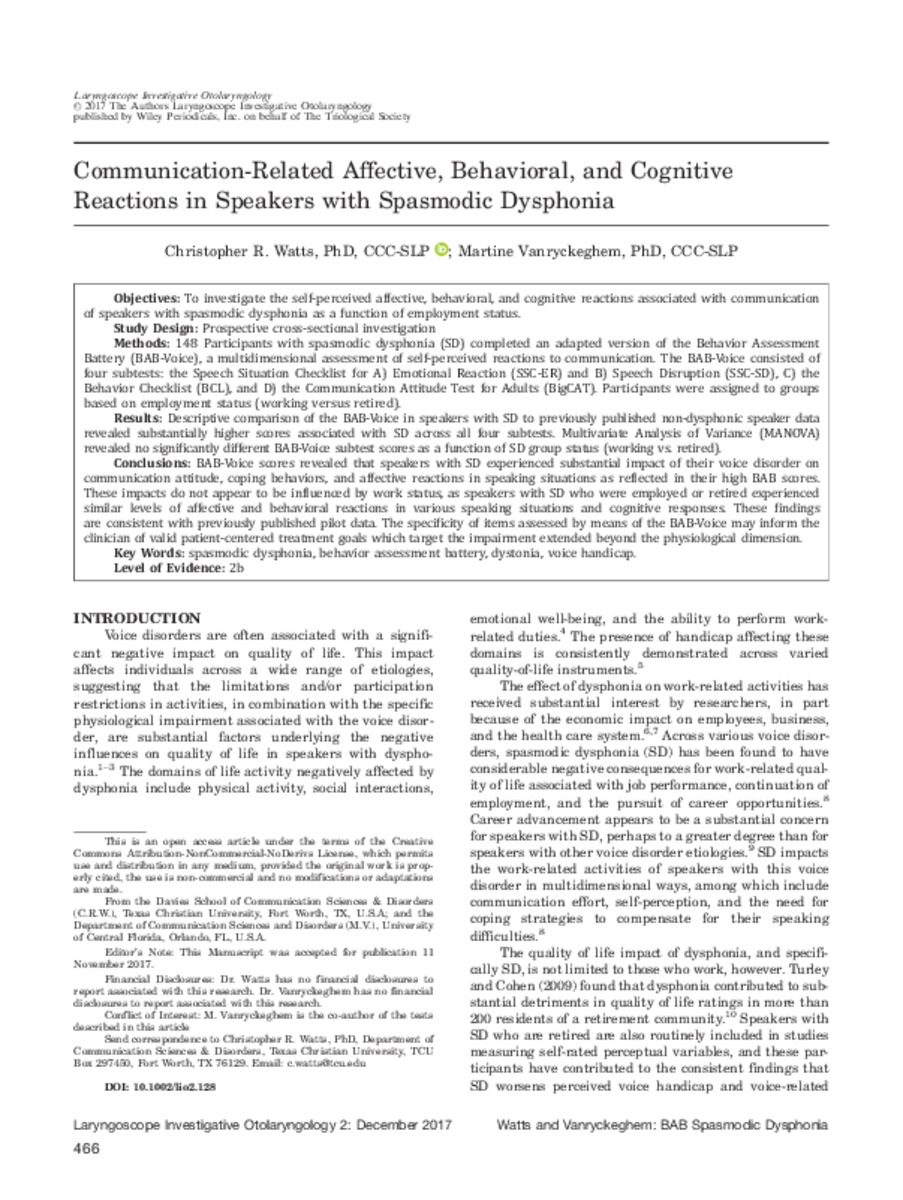Communication-related affective, behavioral, and cognitive reactions in speakers with spasmodic dysphoniaShow full item record
| Title | Communication-related affective, behavioral, and cognitive reactions in speakers with spasmodic dysphonia |
|---|---|
| Author | Watts, Christopher R.; Vanryckeghem, Martine |
| Date | 2017-12-01 |
| Abstract | Objectives: To investigate the self-perceived affective, behavioral, and cognitive reactions associated with communication of speakers with spasmodic dysphonia as a function of employment status. Study Design: Prospective cross-sectional investigation. Methods: 148 Participants with spasmodic dysphonia (SD) completed an adapted version of the Behavior Assessment Battery (BAB-Voice), a multidimensional assessment of self-perceived reactions to communication. The BAB-Voice consisted of four subtests: the Speech Situation Checklist for A) Emotional Reaction (SSC-ER) and B) Speech Disruption (SSC-SD), C) the Behavior Checklist (BCL), and D) the Communication Attitude Test for Adults (BigCAT). Participants were assigned to groups based on employment status (working versus retired). Results: Descriptive comparison of the BAB-Voice in speakers with SD to previously published non-dysphonic speaker data revealed substantially higher scores associated with SD across all four subtests. Multivariate Analysis of Variance (MANOVA) revealed no significantly different BAB-Voice subtest scores as a function of SD group status (working vs. retired). Conclusions: BAB-Voice scores revealed that speakers with SD experienced substantial impact of their voice disorder on communication attitude, coping behaviors, and affective reactions in speaking situations as reflected in their high BAB scores. These impacts do not appear to be influenced by work status, as speakers with SD who were employed or retired experienced similar levels of affective and behavioral reactions in various speaking situations and cognitive responses. These findings are consistent with previously published pilot data. The specificity of items assessed by means of the BAB-Voice may inform the clinician of valid patient-centered treatment goals which target the impairment extended beyond the physiological dimension. |
| Link | https://doi.org/10.1002/lio2.128
https://repository.tcu.edu/handle/116099117/26389 https://onlinelibrary.wiley.com/doi/full/10.1002/lio2.128 |
| Department | Communication Sciences and Disorders |
| Subject | spasmodic dysphonia
behavior assessment battery dystonia voice handicap |
Files in this item
- Name:
- Watts_et_al-2017-Laryngoscope_ ...
- Size:
- 266.1Kb
- Format:
- Description:
- Main article
This item appears in the following Collection(s)
- Research Publications [1008]
© TCU Library 2015 | Contact Special Collections |
HTML Sitemap




